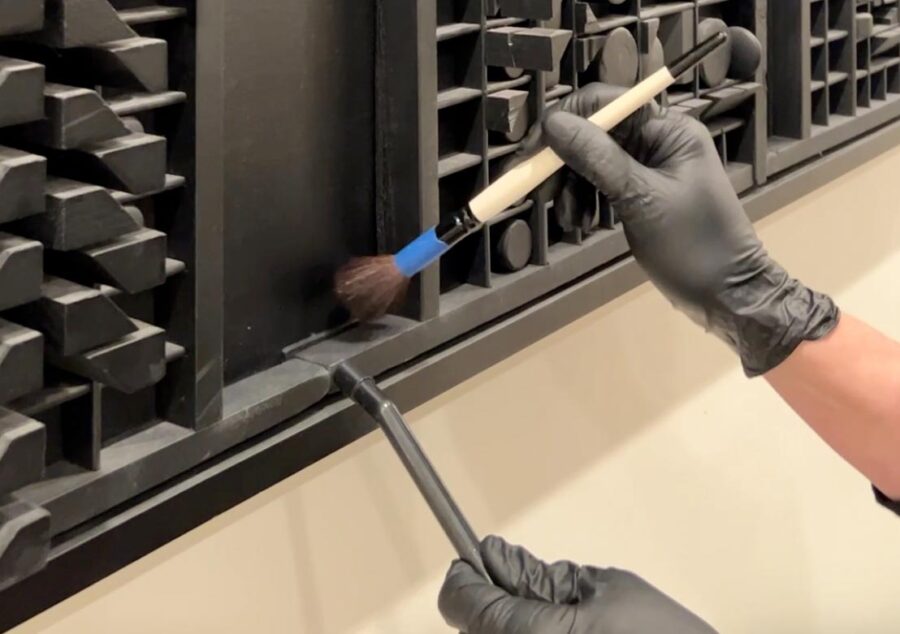
Conservation is integral to the Museum’s mission of making art accessible for current and future generations through the long-term preservation of the collection. Guided by a spirit of learning and connection, we share the ongoing story of preservation so that art remains meaningful and relevant. Through research, technical study, and skilled care, our conservators honor respect for an artist’s original intent while upholding the highest standards of conservation. Follow our projects on PAM’s YouTube and @portlandartmuseum on Instagram.
Conservation staff
Charlotte Ameringer, FAIC
Chief Conservator
charlotte.ameringer@pam.org
Karen Bishop
Assistant Conservator
karen.bishop@pam.org
What‘s a conservator?
The people who do the specialized work of conservation are called Conservators. Think of them as trusted guardians of our artistic heritage. What does one need to be a conservator? Advanced training (read graduate degree) and specialized expertise in art history, materials science, connoisseurship, and conservation techniques, along with a healthy dose of curiosity. Following internationally recognized standards and ethics, these skilled professionals make sure that future visitors can enjoy the same incredible artworks you see today. Conservators collaborate with many other departments at the Museum to enhance understanding of an artwork’s physical and cultural context.
PAM’s conservation history
Before we had our own Conservation Department, the Portland Art Museum relied on visiting conservators who would work on-site for about a month at a time. In 1972, as art conservation was becoming professionalized, PAM established its own conservation studio through grants from the Kress Foundation and the National Endowment for the Arts, as well as through individual donations. As part of our recent campus transformation, the conservation studio received a complete renovation, giving our team state-of-the-art facilities to continue this important work.
Fun Fact – Back in the 1970s, someone donated a Ford Econovan that was transformed into a mobile conservation studio. Because there were so few conservators in the Pacific Northwest, this traveling art ambulance made road trips as far away as Alaska, though it mainly cruised around Oregon, Washington, Montana, and Idaho.

Conservation projects
Unveiling Monet’s Waterlilies: Conserving a PAM Masterwork
One of the Museum’s most cherished and beloved paintings, Claude Monet’s Waterlilies (1914-15), is receiving a long-awaited conservation treatment. Conservation will focus on removing a non-original synthetic resin varnish to return the painting more closely to Monet’s intended appearance.
s.a.m.@PAM – Desalinating a 17th Century Iranian Tile
s.a.m.@PAM: Conserving and Photographing Brancusi’s “A MUSE”
s.a.m. @ PAM: Suzuki Harunobu and Color in Japanese Prints
FAQs
How can I support conservation projects?
If you’d like to donate to the Conservation Department, contact the Development Office at 503-276-4365. To learn more about supporting the Portland Art Museum, please consider donating.
Where can I find a Conservator in the area?
Try the Find a Conservator tool on the AIC website. If have trouble finding a local conservator, send an email to conservation@pam.org. There’s also a short guide on How to Choose a Conservator and printable guides on Caring for your Treasures.
How do I become a Conservator?
Our Become a Conservator guide will help you learn more about the education and training and careers in the field of conservation. To find out more, get involved with the Emerging Conservation Professionals Network and check out the resources they are putting together.
Can I intern or volunteer in the Conservation Department?
We occasionally have internship and volunteer opportunities in the Conservation Department. Internships are listed on our careers page and our volunteer page lists volunteer opportunities. Please direct questions about volunteering to volunteers@pam.org.
Professional organizations
- American Institute for Conservation (AIC)
- Conservation OnLine (CoOL)
- International Institute for Conservation (IIC) of Artistic and Historic Works
- International Council of Museums- Conservation Committee (ICOM-CC)
- The Institute of Conservation
- ICCROM International Centre for the Study for the Preservation and Restoration of Cultural Property
- WAAC Western Association of Art Conservation
- CCI Canadian Conservation Institute